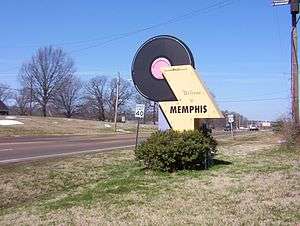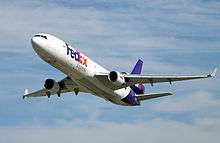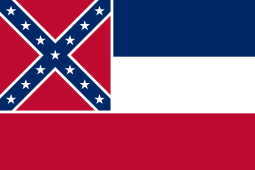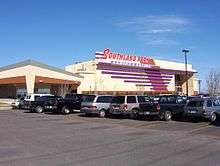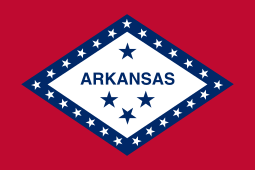Liberty Bowl Memorial Stadium
|
| |
| Former names | Memphis Memorial Stadium (1965–1976) |
|---|---|
| Location |
335 South Hollywood Street Memphis, Tennessee 38104 |
| Coordinates | 35°7′16″N 89°58′39″W / 35.12111°N 89.97750°WCoordinates: 35°7′16″N 89°58′39″W / 35.12111°N 89.97750°W |
| Owner | City of Memphis |
| Operator | Memphis Park Commission |
| Capacity |
59,308 (2013–present) 61,008 (2007–2012) 62,338 (2003–2006) 62,921 (1999–2002) 62,380 (1987–1998) 50,160 (1965–1986)[1][2] |
| Surface |
FieldTurf 2005-2011 Grass 1965-2004 AstroTurf (end zones only 1995 for CFL games; entire field 2012–present) |
| Construction | |
| Broke ground | 1963 |
| Opened | September 16, 1965 |
| Expanded | 1987 |
| Construction cost |
$3.7 million (original) ($27.8 million in 2016 dollars[3]) $19.5 million (1987 renovations) ($40.7 million in 2016 dollars[3]) |
| Architect |
Yeates, Gaskill & Rhodes[4] Bounds & Gillespie Architects (renovations) |
| Tenants | |
|
Memphis Tigers (NCAA) (1965–present) AutoZone Liberty Bowl (NCAA) (1965–present) Tennessee Oilers (NFL) (1997) Memphis Mad Dogs (CFL) (1995) Memphis Maniax (XFL) (2001) Memphis Showboats (USFL) (1984–1985) Memphis Southmen (WFL) (1974–1975) Memphis Rogues (NASL) (1978–1980) | |

Liberty Bowl Memorial Stadium, originally Memphis Memorial Stadium, is a football stadium located at the former Mid-South Fairgrounds in the Midtown area of Memphis, Tennessee, United States. The stadium is the site of the annual AutoZone Liberty Bowl, and is the home field of the University of Memphis Tigers football team. It has also been the host of several attempts at professional sports in the city, as well as other local football games and other gatherings.
History
The stadium was originally built as Memphis Memorial Stadium in 1965 for $3 million, as a part of the Mid-South Fairgrounds, then home to one of the South's most popular fairs, but now conducted in neighboring Desoto County, Mississippi. The fairgrounds also included the now-defunct Mid-South Coliseum (formerly the city's major indoor venue) as well as the now-closed Libertyland amusement park. It was dedicated as a memorial to the citizens of Memphis who had served in World War I, World War II, and the Korean War.
The facility was built partially as a way to bring the Liberty Bowl to a permanent home in Memphis (the game had started in Philadelphia, but because of poor attendance as a northern bowl, it left the city, playing one year in Atlantic City before settling in Memphis). The game was such a success for Memphis that the stadium was renamed Liberty Bowl Memorial Stadium in 1976. As originally built, the stadium was lopsided, with the southwest side being taller than the northeast side. A 1987 expansion brought it to its current, balanced configuration, although with a much greater hospitality building topping the northeast section.[5] Its design is similar to that of old Tampa Stadium ("The Big Sombrero"), with the endzone grandstands being much shorter than the sidelines. The field, which had been natural grass since its inception, was replaced with a FieldTurf surface before the 2005 season; this was subsequently replaced with the modern version of AstroTurf.
The stadium is designed in such a way that all of its seats have a relatively good view of most of the playing surface. This is due primarily to two design factors. The stands are relatively steep for a one-tier, true bowl stadium. Also, there is little space between the side and end lines of the playing surface and the stands.
In December 1983, the playing field was renamed Rex Dockery Field in honor of Rex Dockery, a former Memphis Tigers football coach who died in a plane crash.
The stadium played host to The Monsters of Rock Festival Tour, featuring Van Halen, Scorpions, Dokken, Metallica, and Kingdom Come, on July 9, 1988.
Tenants
Major tenants
Since its opening, the stadium has hosted the Memphis Tigers football team from the University of Memphis. Before this, the team had spent 28 seasons at Crump Stadium. It was not the first time the team had played at the fairgrounds; before playing at Crump, the team had played two seasons there at a former park.[6] As of the start of the 2006 season, the team has a 130-106-7 record at the stadium.
Also since its opening, the stadium has hosted the Liberty Bowl game. It has usually hosted a Southern team playing against an at-large team (usually a team from either the Big 12 or the Southeastern Conference, but occasionally another Southern team). Since 1997, the game has been hosted by the champion of Conference USA, of which the Tigers were a member until 2012. From 1998 to 2003, the opponent was the champion of the Mountain West Conference. This arrangement was ended, however, partially because in the last two years of the agreement, the Mountain West Champion declined to play in the game. The University of Utah turned down the 2004 bid to accept a bid to the BCS and the Fiesta Bowl. The winner of the Western Athletic Conference, Boise State, took the bid instead. In 2005, Fresno State took the bid as an at-large team after Mountain West Champion TCU instead chose to play in the Houston Bowl.
Since 2006, the second bid has gone to a team from the SEC, setting up an all-Southern bowl game. As of 2010, the SEC has the right to override the Conference USA champion and instead replace them with an opponent from the Big East Conference, now the American Athletic Conference. At the same time, the PapaJohns.com Bowl was given the option of a Conference USA team instead of a Big East team.[7] They chose not to do this for the first year of this arrangement, allowing C-USA champions UCF to play Georgia.
The stadium is also the host of the "Southern Heritage Classic", a game between two historically black schools, Jackson State University and Tennessee State University. The stadium also has hosted home games of the Tennessee Vols, Ole Miss Rebels, and Mississippi State Bulldogs.

Early professional football
In 1974 and 1975, the stadium hosted the Memphis Southmen, aka "Grizzlies", of the World Football League. The Southmen drew fairly well, at least by WFL standards, in part due to the presence on their roster of some well-known players recruited away from the NFL at considerable expense. By nearly all accounts, they would have been a viable venture had the WFL been better run. Much, perhaps too much, was read into this relative success at the gate.
When the WFL folded, the team formally changed its name to the Grizzlies and made a bid to join the NFL as an expansion team for the 1976 NFL season, with a telethon even being staged for this purpose. Over 40,000 people bought season tickets for the would-be NFL team. Despite this seemingly overwhelming show of support, the NFL ignored Memphis' pleas and the Southmen folded. Owner John Bassett filed a lawsuit against the league, but was unsuccessful.
In 1984, the United States Football League added the Memphis Showboats as an expansion team. The Showboats, featuring defensive end Reggie White and coached by flamboyant Memphian Pepper Rodgers, were one of the better draws in the league. They advanced to the semifinals in 1985. Much like the Southmen before them, it was generally believed the Showboats would have been a viable venture had their league been better organized.
However, this attempt caused the city of Memphis to decide on expanding the stadium, in the hopes of luring an NFL franchise to the city. To this end, the Liberty Bowl underwent a $12 million facelift. The east stands were built up to the same level as the west ones, adding about 12,000 seats, and a "skybox" of luxury suites was added to the top of those stands. After the renovation, the then-St. Louis Cardinals played an exhibition game there before a sellout crowd.
Despite its efforts, the city was unsuccessful in luring an NFL team (which would have been called the "Memphis Hound Dogs") to the Liberty Bowl.
Mad Dogs
Not willing to give up on pro football, in 1995 the Liberty Bowl welcomed the Memphis Mad Dogs as part of the Canadian Football League's attempt at bringing their league into American markets.
Due to the design features noted earlier, it was extremely difficult to shoehorn a Canadian football field onto the Liberty Bowl's playing surface. Canadian fields are 10 yards longer and 35 feet wider than in the U.S. version, and the end zones are 20 yards deep rather than 10; few U.S. football stadiums are designed readily to accommodate a playing surface of this size. Had the attempt to play the Canadian game included an attempt to use the full width of that game's field, players not participating in the game and the coaching staffs would have to have been seated in the stands. Likewise, 20 yards past the goal line at the Liberty Bowl puts one several rows up into the end zone stands. AstroTurf sections were added around the grass field to accommodate the required width, while the end zones became half AstroTurf/half grass pentagons in order to bring the field to the required length. However, the end zones were nowhere near regulation; they averaged around 9 yards in length, and no other American stadium had end zones shorter than 15 yards. The stands jutted into the corners of the end zones, creating a distinct safety hazard. The only real concession to the Canadian format that was feasible at the Liberty Bowl was the moving of the goal posts to the goal line, where they are in the Canadian game, as opposed to the end line. The result was what amounted to a hybrid game, played by Canadian rules on essentially a U.S. field.
Despite these limitations, the Mad Dogs, coached by Rodgers, drew fairly well during the early part of the season. However, they were tripped up by quirks in the CFL schedule. The CFL season runs from July–November so as to conclude before the harsh Canadian winters set in and make conditions unbearable for players, coaches, officials, and especially spectators. Its games were generally scheduled for Thursday, Friday and Saturday nights—the same nights on which high school and college football games are played in the United States. The Mad Dogs knew that once college football season started, most fans preferred to drive across Interstate 40 to watch Tennessee football or down Interstate 55 to watch Ole Miss. (The Birmingham Barracudas CFL franchise faced similar problems due to competition from Alabama and Auburn.) With this in mind, the CFL moved the Mad Dogs and Barracudas' late season home games to Sunday afternoons, but this put them in direct competition with television broadcasts of the far more popular NFL. However, even with these changes, the Liberty Bowl became a virtual ghost town late in the season, with several crowds well below 10,000. It soon became apparent that the Mad Dogs were not a viable venture. Although they finished one game out of the playoffs, their dreadful attendance figures caused them to fold at the end of the season.
Oilers
The city finally lured an NFL team to the stadium in 1997, when the Houston Oilers announced that they would play two seasons in Memphis as the Tennessee Oilers before the Adelphia Colisseum, their new stadium in Nashville (now Nissan Stadium), was completed in time for the 1999 season. The largest stadium in Nashville at the time, Vanderbilt Stadium, then seated only 41,000 fans—too few even for temporary use. Vanderbilt University was also unwilling to let beer be sold at games. Although the Vols' Neyland Stadium in Knoxville was slightly closer to Nashville, it was deemed too big (at over 102,000 seats) for an NFL team. Pepper Rodgers was named the Oilers' "Director of Memphis Operations." The team was to live and practice in Nashville, commuting to Memphis only for games.
Although the idea seemed acceptable enough to the league and the team at the time, the 1997 season was an unmitigated disaster for all involved. The Oilers played before some of the smallest home crowds seen in the NFL since the 1950s for most games, and the visiting teams often seemed to have more supporters than the Oilers. Many Memphians wanted nothing to do with a team which would be lost in two years—especially to longtime rival Nashville. For their part, Nashvillians were skittish about having to drive 210 miles to see "their" team play. In an unfortunate coincidence, Interstate 40 was undergoing extensive repairs just east of Memphis at the time. This lengthened the normal three-and-a-half hour drive from Nashville to Memphis to five hours or longer. Even though none of the Oilers' first seven games attracted more than 27,000 people, Oilers' owner Bud Adams was initially willing to stick it out in Memphis for one more season. However, that changed with the only game that drew more fans than could have comfortably been accommodated at Vanderbilt, the year's final game against the Pittsburgh Steelers. While 50,677 people showed up, the great majority of them (three-fourths of the crowd, by one estimate) were Steeler fans.[8] Adams was so disgusted that he ripped up the Memphis agreement a year early in favor of playing at Vanderbilt in 1998.
Maniax
The stadium's last major professional tenant to date was the Memphis Maniax of the XFL. They finished tied for second place at 5-5 with the Demons, but did not make the playoffs. The league folded after one season.
Other former tenants
From 1978 to 1980, the Memphis Rogues of the North American Soccer League called the stadium home. The playing surface is somewhat smaller than that generally favored by soccer, but that sport adapts to smaller playing surfaces better than some others (the preferred width of a soccer pitch is 70 to 80 yards, but the rules allow for a pitch as narrow as 50 yards wide). Like the Southmen, the Rogues seemingly did fairly well in a league that wasn't doing all that well as a whole. Despite their success, the team moved to Calgary, although this move was due more to the owner, Nelson Skalbania, a Canadian businessman, wanting to move the team to his home country.
One of the more interesting events held in the stadium was an exhibition Major League Baseball game involving the Atlanta Braves and Milwaukee Brewers during the 1975 season. The game was sponsored by the Memphis Blues minor league team. The right-field fence was only 174 feet from home plate, about 125 feet shorter than the dimensions of most major league parks.
Future
As of 2016, it is considered highly unlikely that there will be a permanent NFL franchise in the stadium or in the city. The stadium is more than adequate for the Tigers, a team which is currently playing in one of the larger stadiums in its new conference, the American Athletic Conference. The AutoZone Liberty Bowl game is well-attended and averages crowds just under the stadium's maximum capacity. There are a variety of factors that play into the city's prospects, including:
- Memphis, although it is the largest city in the state, is now considered to be in the Titans’ market under the current television agreements in the NFL. Also, while Memphis is the 18th-largest city in the United States, it has always been only a medium-sized television market (currently 44th), as the surrounding metropolitan area is not much bigger than the city proper. Its per capita income is far less than is customary for a market that is usually under consideration for expansion or relocation of an existing team.
- The league itself is not in the position to be considering expansion at this time, in part due to there being a balanced schedule which works well in place. in place. In addition, the city is located within 500 miles of six current teams: the Titans, New Orleans Saints, Dallas Cowboys, Atlanta Falcons, Kansas City Chiefs, and Indianapolis Colts.
- The city, county and state have already pumped a large amount of capital into several other structures in the city. The Pyramid was completed in 1991 and has already been replaced. FedExForum, which replaced The Pyramid, and AutoZone Park were both completed in the first five years of the 2000s, and neither structure has yet to pay off any funds spent on its construction. Each of these venues cost several times more than has ever been spent on the Liberty Bowl.
- Finally, the stadium itself is considered obsolete by current NFL standards. It does not have many luxury boxes, and it does have a large number of backless bench seats, both of which are substantial drawbacks. Restroom facilities and concession stands seem relatively antiquated compared to those of newer facilities. The facility itself generally shows the five decades of use and Mid-South weather that it has endured. Perhaps the greatest hindrance is the one thing about its design that originally had made it so attractive to many. The single-deck, open bowl design precludes the construction of true "club seats", the luxury seats located between the main lower and upper decks of most modern football stadiums which are a major source of additional revenues to ownership. Due to the factors listed above, it is highly unlikely that a major upgrade could be performed on the stadium; it would almost be certainly more practicable to replace it with an entirely new structure.
On January 1, 2007, then-Memphis Mayor Willie Herenton proposed a new stadium be built in place of the old one. Some in the University of Memphis community prefer the construction of a smaller, on-campus stadium, but such a venue would almost certainly be inadequate for the Liberty Bowl. Although this proposal did not move ahead, the long-term future of Liberty Bowl Memorial Stadium is currently unclear. However, it is thought that a separate on-campus stadium for the Tigers would be fiscally unrealistic if a new municipal stadium were to be built in addition to it.
Legacy
Both the Liberty Bowl and the stadium bearing its name have been integral parts of the Memphis community for over five decades, and it can be argued that, unlike the cases of massive amounts that have been spent on many luxurious sports venues for professional sports teams in other cities in recent years, the citizens of Memphis have received a reasonable return on the capital invested in the stadium in the economic activity resulting from all of the events that the stadium has hosted over the years.
The failure of the Liberty Bowl to become the long-term host of a successful professional football team has been more a result of the poorly planned and executed sports leagues that have attempted to operate teams there than any inherent fault in the stadium, which was superior to many hosting major sports teams at the time of its construction, or the Memphis market.
The stadium, despite all its faults, must be deemed to have been largely successful. It has provided the University of Memphis football team with a more-than-suitable home, and the City of Memphis a venue for other large events and an annual attraction that may not be in the top echelon of collegiate sports but nonetheless provides crowds at Memphis hotels and restaurants annually at a time when they would ordinarily be lacking, the last week in December. The Southern Heritage Classic, usually played near the beginning of the football season in September, has become one of the premier events in black collegiate sports and always brings a large crowd (sometimes 60,000 or more). Additionally, the Liberty Bowl game has seen some of its best days since playing host to the champion of Conference USA beginning in 1997. The 2007 Liberty Bowl set an all-time attendance record for the Liberty Bowl Game as 63,816 fans packed the stadium to watch Mississippi State University defeat the University of Central Florida.
The all-time Liberty Bowl Stadium attendance record was set in 1990 when 66,000+ watched Ole Miss square off against rival Tennessee in a regular season battle that proved to be for the outright SEC Championship for that season with the Volunteers prevailing 22-13.[9]
Recent renovations
In 2011, the Liberty Bowl received some major upgrades such as new lighting, two new video boards, one of which is a Jumbotron, new elevators, new turf, new paint and renovations to the luxury boxes.
In popular culture
In the SpongeBob SquarePants episode "Band Geeks", the band led by Squidward Tentacles plays at the "Bubble Bowl", during which clips of a Memphis Showboats game (played at the Liberty Bowl) are shown.
References
- ↑ Bailey, Jr., Thomas (April 8, 2013). "Memphis Gets Building Permit for Liberty Bowl Memorial Stadium Upgrades". The Commercial Appeal. Memphis. Retrieved August 20, 2013.
- ↑ "2013 Memphis Football Media Guide". Memphis Athletics. p. 3. Retrieved August 7, 2014.
- 1 2 Federal Reserve Bank of Minneapolis Community Development Project. "Consumer Price Index (estimate) 1800–". Federal Reserve Bank of Minneapolis. Retrieved October 21, 2016.
- ↑ http://www.emporis.com/building/libertybowl-memphis-tn-usa
- ↑ http://stadiumdb.com/stadiums/usa/liberty_bowl_stadium
- ↑ Jennifer Rodrigues, ed. The 2006 University of Memphis Football Media Guide. Birmingham, Ala.: EBSCO Media, 2006, p. 184.
- ↑ http://www.newsobserver.com/2010/04/28/456893/big-east-gets-liberty-bowl-option.html
- ↑ Bouchette, Dan (November 29, 2001). "Steelers-Oilers/Titans Rivalry Plays Its Final Act in Pittsburgh Under the Monday Night Spotlight". Pittsburgh Post-Gazette. Retrieved August 20, 2013.
- ↑ https://www.youtube.com/watch?v=cJ8N4jskmZs
External links
| Events and tenants | ||
|---|---|---|
| Preceded by Crump Stadium |
Home of the Memphis Tigers 1965 – present |
Succeeded by Current |
| Preceded by Convention Hall |
Home of the Liberty Bowl 1965 – present |
Succeeded by Current |
| Preceded by Astrodome |
Home of the Tennessee Oilers 1997 |
Succeeded by Vanderbilt Stadium |
